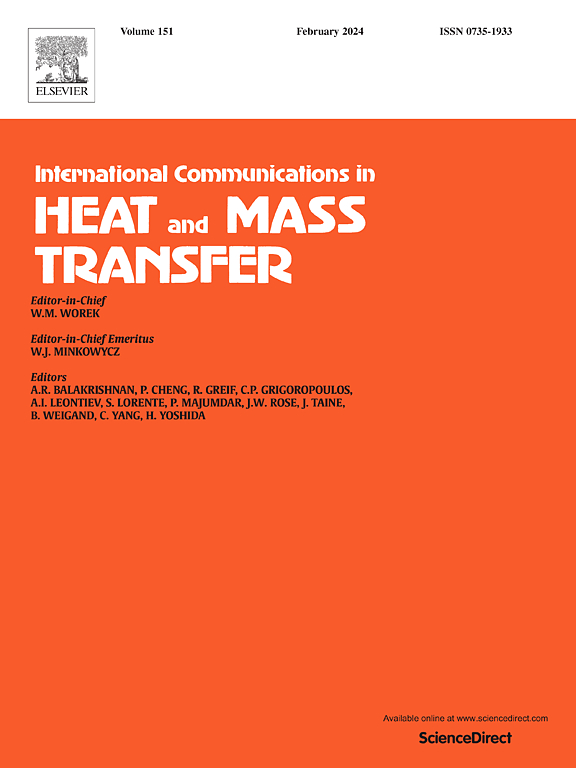Study on the coupling mechanism between dispersed fuel flow and central thermal field
IF 6.4
2区 工程技术
Q1 MECHANICS
International Communications in Heat and Mass Transfer
Pub Date : 2025-07-17
DOI:10.1016/j.icheatmasstransfer.2025.109372
引用次数: 0
Abstract
During the dispersion of liquid fuel, the high-intensity energy field released by central charge detonation can easily trigger premature-ignition of the fuel cloud, leading to the early release of chemical energy and weakening the destructive power of detonation. In this paper, a dynamic temperature field calculation model based on specific internal energy during central charge detonation is proposed, achieving a relative error of less than 1.3 %–1.9 % compared to experimental values and effectively capturing transient temperature fields. Using this model, the temperature field and its coupling with the concentration distribution of the dispersed fuel cloud in a Fuel Air Explosive (FAE) device were obtained. It is shown that when the detonation products temperature exceeds the ignition temperature of propylene-oxide (693.15 K) and the fuel cloud concentration falls within the sensitive range of 72–959 g/m3, local mixed zones can initiate self-sustained combustion through the synergistic effects of heat conduction and droplets evaporation. Accordingly, a combustion initiation mechanism and a premature-ignition prediction model for the fuel dispersion process are proposed. Furthermore, a hazard classification of the spatiotemporal regions prone to premature-ignition was conducted. These insights provide important guidance for improving fuel utilization efficiency and enhancing the power of FAE.

分散燃料流与中心热场耦合机理研究
在液体燃料弥散过程中,中心装药爆轰释放的高强度能量场容易引发燃料云的早燃,导致化学能的提前释放,减弱了爆轰的破坏力。本文提出了一种基于比内能的中心装药爆轰过程动态温度场计算模型,与实验值的相对误差小于1.3% ~ 1.9%,能有效地捕捉瞬态温度场。利用该模型,得到了燃料空气爆炸装置内分散燃料云的温度场及其与浓度分布的耦合关系。结果表明,当爆轰产物温度超过环氧丙烷的着火温度(693.15 K),燃料云浓度在72 ~ 959 g/m3的敏感范围内时,局部混合区可以通过热传导和液滴蒸发的协同作用启动自燃。在此基础上,提出了燃料分散过程的起燃机理和早燃预测模型。此外,还对易发生过早着火的时空区域进行了危险性分类。这些见解为提高燃油利用效率和增强FAE功率提供了重要指导。
本文章由计算机程序翻译,如有差异,请以英文原文为准。
求助全文
约1分钟内获得全文
求助全文
来源期刊
CiteScore
11.00
自引率
10.00%
发文量
648
审稿时长
32 days
期刊介绍:
International Communications in Heat and Mass Transfer serves as a world forum for the rapid dissemination of new ideas, new measurement techniques, preliminary findings of ongoing investigations, discussions, and criticisms in the field of heat and mass transfer. Two types of manuscript will be considered for publication: communications (short reports of new work or discussions of work which has already been published) and summaries (abstracts of reports, theses or manuscripts which are too long for publication in full). Together with its companion publication, International Journal of Heat and Mass Transfer, with which it shares the same Board of Editors, this journal is read by research workers and engineers throughout the world.

 求助内容:
求助内容: 应助结果提醒方式:
应助结果提醒方式:


